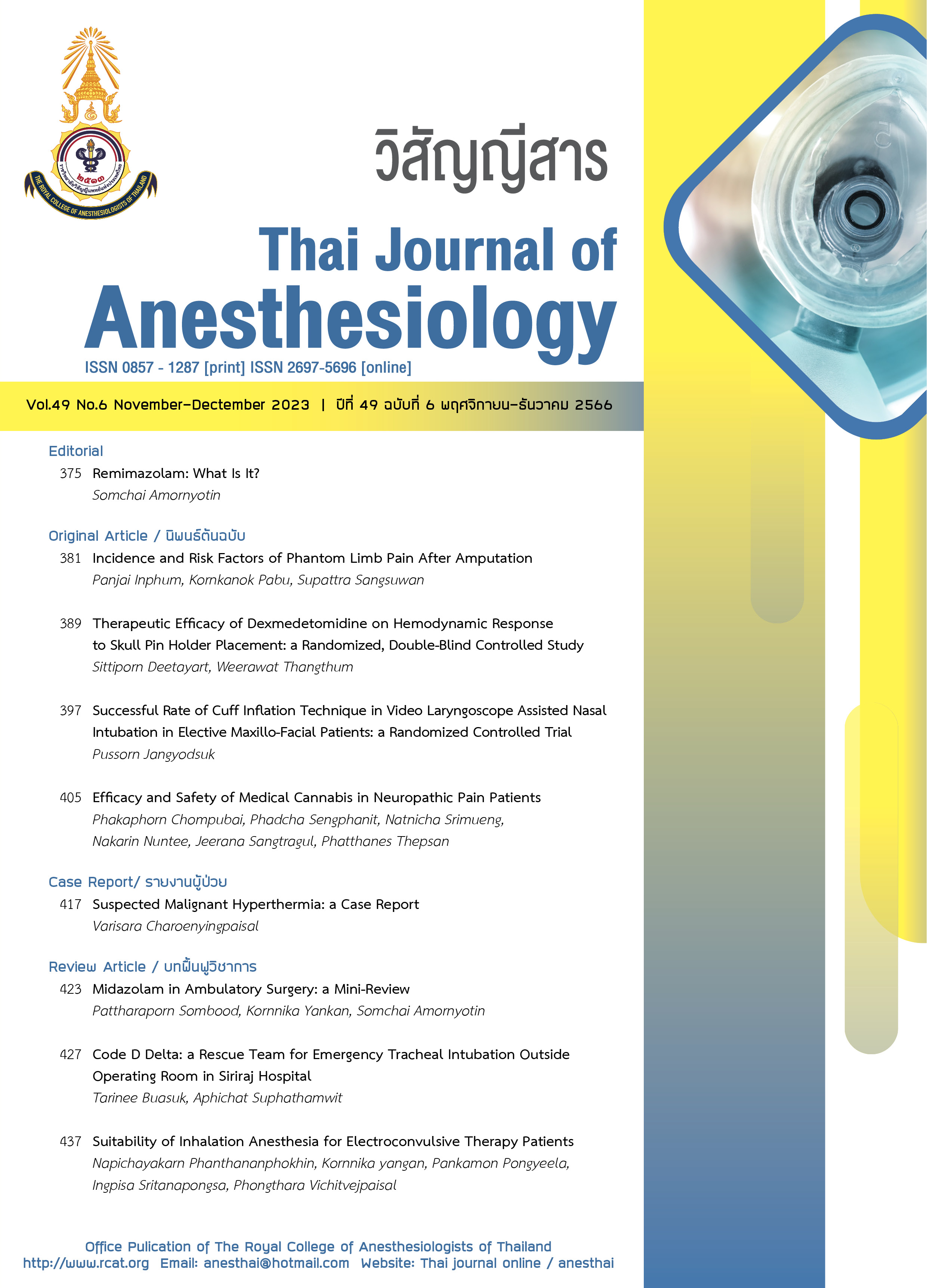Successful Rate of Cuff Inflation Technique in Video Laryngoscope Assisted Nasal Intubation in Elective Maxillo-Facial Patients: a Randomized Controlled Trial
Main Article Content
Abstract
Background: Video laryngoscope with Magill forceps usage is the popular method for nasal tube intubation. Normally the success rate of nasal tube intubation depends on the matched alignment between endotracheal tube and glottis. With Magill forceps usage, we can control the tip of nasal tube, but this equipment also increases the risk of oral soft tissue injuries. Cuff inflation in nasal tube (NT) is another method to make tube stay in good alignment with glottic opening which should increase the success rate for NTI without injury. The aim of the study is to evaluate the success rate of cuff inflation technique under video laryngoscope for NTI compared to Magill usage. Methods: 80 patients undergoing elective Maxillo-facial surgeries under GA who could not pass the NT by VL alone were randomized into two groups (40 per group). NTI in Group B were intubated by cuff inflation method, NTI in group M were intubated by Magill forceps method. Primary outcome was succession rate of NTI by cuff inflation technique. Secondary outcomes were insertion duration, and complications. In Statistical analysis by STATA v.15, Descriptive statistic, inferential statistics, unpaired t-test, P-value <0.05 was considered significant. Results: All NTIs were successfully completed. There was a significant difference in the duration of insertion. Group B was 15.1±10.8 sec, and group M was 20.4±9.4 sec (P=0.02). Procedure-related complications in both groups were not different (P>0.05). Conclusion: All NTIs were completed successfully. The cuff inflation technique reduced the time usIng for intubation compared to the Magill forceps technique and complications were not different between the two groups.
Article Details

This work is licensed under a Creative Commons Attribution-NonCommercial-NoDerivatives 4.0 International License.
References
Folino TB, Mckean G, Parks LJ. Nasotracheal intubation. StatPearls Publishing; [cited 2022 Jan]. Available from: https://www.ncbi.nlm.nih.gov/books/NBK499967/.
Mahajan R, Batra YK, Kumar S. Another use of Magill forceps to assist nasotracheal intubation. Can J Anaesth. 2007;54:957-8.
Arshad Z, Abbas H, Gupta L, Bogra J. Magill forceps-an aid for difficult intubation. Intern
J Anesthesiol. 2013;31:1.
Yeom JH, Oh MK, Shin WJ, Ahn DW, Jeon WJ, Cho SY. Randomized comparison of the effectiveness of nasal intubation using a GlideScope video laryngoscope with Magill forceps versus vascular forceps in patients with a normal airway. Can J Anaesth. 2017;64:1176-81.
Shah KG, Shah BC, Patel M. Effect of cuff inflation technique in video laryngoscopic assisted nasal intubation in oral cancer surgeries. Med J DY Patil Vidyapeeth. 2019;12:340-4.
Gorback MS. Inflation of the endotracheal tube cuff as an aid to blind nasotracheal intubation. Anesth Analg. 1987;66:916-7.
Khadake SM, Swamy G, Deshmukh AG, Gujar S, More GS, Ratheesh GK. Cuff inflation technique under king vision video laryngoscope superior to conventional method of Magill forceps for nasotracheal intubation. Sch J App Med Sci. 2016;4:1226‑30.
Van Elstraete AC, Pennant JH, Gajraj NM, Victory RA. Tracheal tube cuff inflation as an aid to blind nasotracheal intubation. Br J Anaesth. 1993;70:691-3.
Gupta N, Garg R, Saini S, Kumar V. GlideScope video laryngoscope‑assisted nasotracheal intubation by cuff‑inflation technique in head and neck cancer patients. Br J Anaesth. 2016;116:559‑60.
Yamamoto T, Flenner M, Schindler E. Complications associated with nasotracheal intubation and proposal of simple countermeasure. Anaesthesiol Intensive Ther. 2019;51:72-3.
Özkan ASM, Akbas S, Toy E, Durmus M. North polar tube reduces the risk of epistaxis during nasotracheal intubation: a prospective, randomized clinical trial. Curr Ther Res Clin Exp. 2019;90:21-6.
Hazarika H, Saxena A, Meshram P, Bhargava AK. A randomized controlled trial comparing C Mac D blade and Macintosh laryngoscope for nasotracheal intubation in patients undergoing surgeries for head and neck cancer. Saudi J Anaesth. 2018;12:35-41.
Patil VV, Subramanya BH, Kiranchand N, Bhaskar SB, Dammur S. Does C‑MAC® video laryngoscope improve the nasotracheal intubating conditions compared to Macintosh direct laryngoscope in paediatric patients posted for tonsillectomy surgeries? Indian J Anaesth. 2016;60:732‑6.


